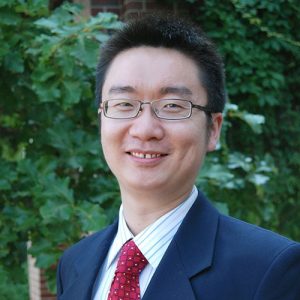 Led by NC State Chemical Engineering professor Fanxing Li, research on a hybrid solar-redox process, which converts solar energy and methane into separate streams of liquid fuels and hydrogen through the assistance of an oxygen carrier, has the potential to produce transportation fuels and hydrogen at a much higher efficiency. Dr. Li and his team have developed materials that are over 7 times more effective in CO2-splitting and materials showing exceptional efficacy for water splitting and methane partial oxidation when compared to state-of-the-art. Such performance has never been previously attained and exhibit potential for economical and environmentally friendly methods to utilize CO2 in a carbon neutral or even negative manner.
Led by NC State Chemical Engineering professor Fanxing Li, research on a hybrid solar-redox process, which converts solar energy and methane into separate streams of liquid fuels and hydrogen through the assistance of an oxygen carrier, has the potential to produce transportation fuels and hydrogen at a much higher efficiency. Dr. Li and his team have developed materials that are over 7 times more effective in CO2-splitting and materials showing exceptional efficacy for water splitting and methane partial oxidation when compared to state-of-the-art. Such performance has never been previously attained and exhibit potential for economical and environmentally friendly methods to utilize CO2 in a carbon neutral or even negative manner.
Dr. Li reports 5 published articles in peer-reviewed journals, 1 invention disclosure, 4 conference presentations, 5 invited seminars, 2 graduate students, and 5 undergraduate researchers. Dr. Li has established collaborations with Prof. Hong Yang at the University of Illinois Urbana Champagne, Prof. John Newman at UC Berkeley, Prof. Hanjing Tian at the West Virginia University, Prof. Christoph Muller at ETH Zurich, and Prof. Israel Wachs at Lehigh University. Specifically, Kenan Institute support has enabled Dr. Li to publish a number of peer-reviewed articles in leading energy journals including Environmental Science and Technology, Energy, ACS Catalysis, Applied Energy, and Energy Technology. These published articles cover topics ranging from novel redox catalyst design and reaction mechanisms to process simulation and investigation of the attrition rate and underlying mechanism for redox catalysts. Three additional manuscripts are currently being reviewed by top journals in the field. One new invention disclosure is being finalized for submission.
The project has resulted in significant innovations and created education opportunities for students ranging from K-12 to graduate level. Dr. Li has hosted five undergraduate students to conduct research related to the project on both voluntary and paid basis. Two undergraduate students coauthored a journal article (in Applied Energy) resulting from their undergraduate research. A Ph. D. student, Nathan Galinsky, won the inaugural James K. Farrell outstanding Ph.D. graduate award.
